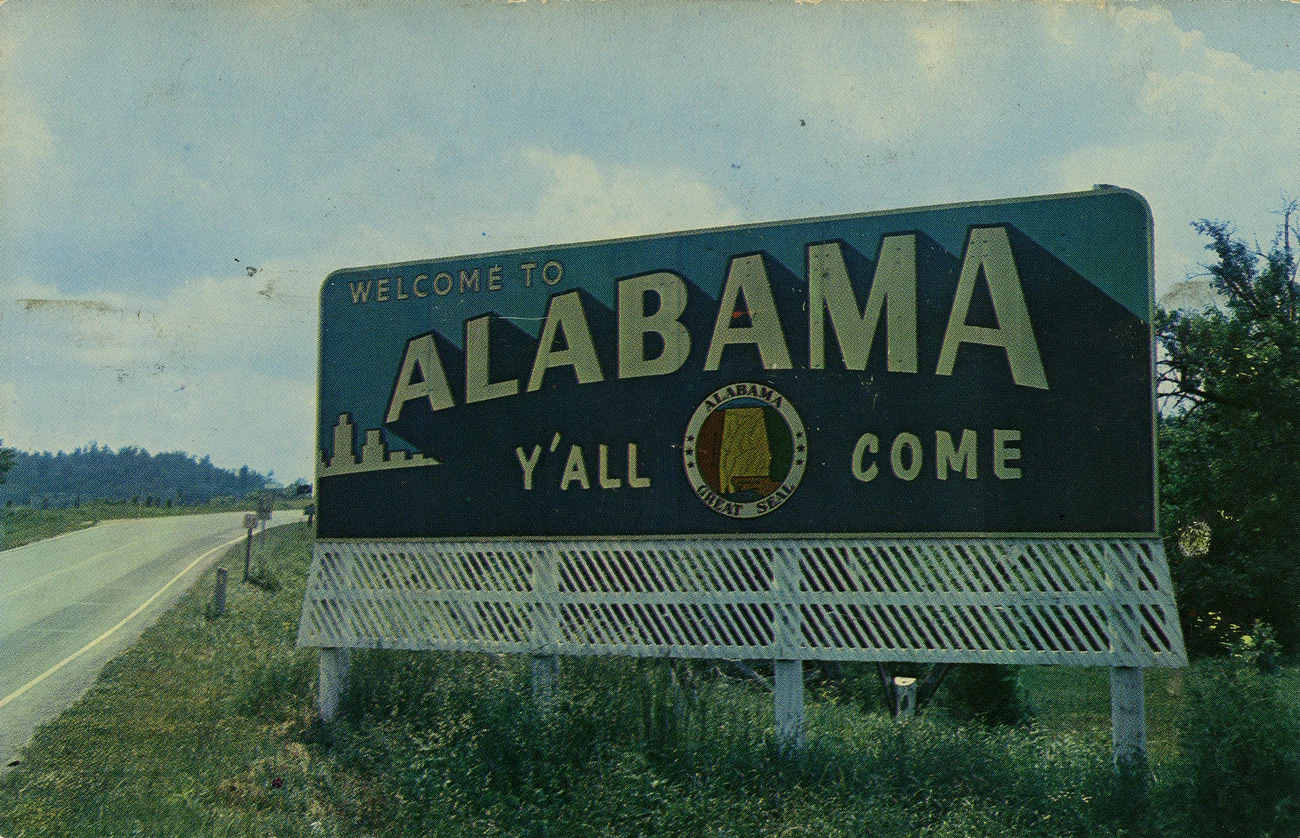Part of a series of articles titled The Watsons Go to Birmingham—1963.
Article
Chapter 11: Bobo Brazil Meets the Sheik

Alabama Department of Archives and History.
Kenny briefly wakes and finds himself in the front seat, with Dad behind the wheel smiling, and "Yakety Yak" playing on repeat.
When he wakes again, the sun is bright and Joey is also in the front seat, drooling all over him. "Yakety Yak" is still skipping. As Kenny and Joey drift in and out of sleep, Dad keeps driving and smiling. But he is starting to look dead tired. His beard is growing in and even more alarming, he is listening to country music on the radio! Dad jokes that he is changing his name to Clem, and he gives the rest of the family country names, too. Momma joins in on the fun and speaks "super-Southern style." It turns out that Dad has driven 18 hours straight! Dad jokingly explains that this required two kinds of mind power: focusing on the hum of the road and making vacuum sounds, which, according to an article he read, could lull someone to sleep.
Soon enough, the Watsons arrive at Grandma Sands’ house in Birmingham, Alabama. Kenny is surprised to discover that the neighborhood looks a lot like Flint, only with Alabama's famous sun and heat. Grandma Sands isn’t the big, mean-looking troll Kenny had imagined; instead, she is teeny-tiny and looks like an older, shrunken version of Momma. Smiling and crying, Grandma Sands hugs each of the Watson children, saying "my family, my beautiful, beautiful family." Grandma Sands keeps referring to a "Mr. Robert" like they are inseparable, and Momma wants to know who the man is. Grandma Sands tells her they will have plenty of time to talk, and immediately puts Byron to work, sending him out to the corner store to purchase ingredients for dinner. Although Kenny was expecting a great clash between "the two meanest, most evil" people he knows, Byron is so respectful and polite that it seems he has already surrendered to Grandma Sands.

Federal Highway Administration, America's Highways 1776–1976: A History of the Federal-Aid Program (Washington, DC: United States Department of Transportation, 1976), 277.
Fact Check: Was it possible to drive from Flint to Birmingham in 18 hours in 1963?
What do we know?
Today, the drive from Flint to Birmingham takes around 11 hours on I-75 (the interstate highway), and there are comfortable rest areas along the entire route. But in 1963, some segments of interstate highway were not yet built, including stretches of I-75 in Kentucky and Tennessee. So, when Kenny comments in chapter 9 that the whole drive would take place on "a road that runs all the way from Flint to Florida. One road!" he is not exactly correct. The family would have had to drive on local roads in places where there was no interstate. The speed limit on local roads was slower, the road quality more uneven, and necessities like gas stations and restrooms more difficult to locate (and often unfriendly to outsiders). As a result, the trip to Birmingham would have taken about 18 hours in 1963, longer than it does today.
What is the evidence?
Primary source: Federal Highway Administration, "The national system of interstate and defense highways," map, in America's Highways 1776–1976: A History of the Federal-Aid Program (Washington, DC: United States Department of Transportation, 1976), 277.
This road map represents the status of the Interstate Highway System construction around the early 1960s.
Primary Source: Standard Oil Company, "Road map of Kentucky Tennessee" (Convent, NJ: General Drafting Company, 1963).

Standard Oil Company, "Road map of Kentucky Tennessee" (Convent, NJ: General Drafting Company, 1963).
This road map is zoomed in to the Kentucky-Tennessee border, where I-75 sections are still being constructed. To follow the path of the Watsons' drive, locate the black arrow at the center. The arrow points to a line of dark dashes, which indicates proposed sections of the interstate. The orange arrow points to a roadway colored with small red dashes. These symbols show where highway construction is underway, and families like the Watsons would have taken detours.
Primary source: William D. Laffler, "Interstate routes trim travel time," The Washington Post and Times Herald (Washington, DC), May 16, 1965, M11.
"Only a few years ago a motorist had to do some hard driving to go 450 miles in one day. Now the man or woman [driver] at the wheel can cover 600 miles easily and with little effort. Shrinking of traveling time has been made possible by the Nation’s network of interstate highways. More than 22,000 miles of the projected 41,000-mile system is now open to traffic. ...Opening of the interstate system is causing a revolution, too, in businesses which are dependent on the highways for existence. Motels, restaurants and service stations are forming 'one-stop service complexes' to serve travelers' needs with a minimum of inconvenience."

Popular Mechanics 118, no. 6 (December 1962), 90.
Kenny's dad puts the rest of the Watsons to sleep by humming the sound of a vacuum in the final leg of their trip.
Fact Check: Can a sound like this actually put someone to sleep?
What do we know?
Some research claims that white noise, or a mixed range of sound that covers all audible frequencies [waves occurring in a random manner at a single volume], can help people fall asleep. The static sounds heard when someone moves between different radio stations is an example of white noise. Fans and vacuum cleaners that produce repetitive buzzing sounds can also act as white noise. During the postwar period, white noise machines were marketed as a sleep aid, particularly for infants.
How does white noise work in the brain? The brain is affected by brain waves, which are electric sensations produced by neurons (nerve cells) sending messages to one another. Neurons communicate these messages constantly, helping a human feel emotions, form memory and thoughts, and sense the world around them. Brainwaves move at different frequencies, and the speed of the frequency depends on the activity of neurons. If someone experiences slow brain waves (also called alpha waves), the individual will start to feel tired and calm. Sleep occurs at even slower brain waves (theta and delta waves) and frequencies. Environmental conditions—music, human activity, and nature—can directly or indirectly alter the frequencies of these brain waves.
What is the evidence?
Primary Source: Phyllis Battelle, "Hummer soothes fussy babies," The Detroit News (MI), September 22, 1961, 22.
"Doctor [Robert] Horton knew something else. Whenever he had taken either of his 'fuss budget-babies' for a drive in the car they had immediately fallen sweetly asleep. They also slept in planes. And they quieted down when the vacuum cleaner was humming nearby. ...Months later, with the help of scientists at Minneapolis-Honeywell, he developed a transistorized speaker, powered by a small pen-light battery, enclosed in a styrene case about the circumference of a saucer. Turned on, it produces a soft, steady hum pitched at B flat, one octave below middle C in tone. ...for slightly more than 90 per cent of the babies tested, the humming sound put fiercely crying infants to sleep within from 30 seconds to five minutes. First the little howlers would stop screaming to listen, then they'd look around wide-eyed, and then they'd drop off... The doctor wants it made clear that only 25 to 30 per cent of newborn infants need the slumber tone—'because most babies are not fussy, will fall asleep without extra urging.'"
Primary source: "Artificial sounds soothe," advertisement, Popular Mechanics 118, no. 6 (December 1962), 90.
Secondary source: J A D Spencer et al., "White noise and sleep induction," Archives of Disease in Childhood 65, no. 1 (1990): 135-37, http://doi.org/10.1136/adc.65.1.135.
Using a white noise generator, the researchers attempted to mimic the calming sounds a baby might hear while still in the womb in order to assess if similar noises would settle babies that were 2 to 7 days old.
"The intensities produced by the white noise device used in this study correspond to the noise level of a domestic vacuum cleaner or inside a small saloon [sedan] car travelling at 50 kph [31 mph]. This randomized study has shown that, when exposed to white noise, the likelihood of a baby falling asleep is increased more than threefold (25% to 80%). Those that responded did so within a short period of time and before the white noise device ended its emission. ...The noise of hair dryers and vacuum cleaners is known to settle infants and promote sleep. White noise probably acts by masking other external noises thereby removing such arousal stimuli and calming the baby."

Voices from the Field
"Language Variation" by Tracey Weldon, a professor of English and Dean of the Graduate School and Vice Provost of Graduate Education at the University of South Carolina. Weldon is also a co-associate producer of the documentary Talking Black in America.
Photos & Multimedia

Image courtesy of Hoover Historical Center/Walsh University, North Canton, Ohio.
Writing Prompts
Opinion
Kenny describes Grandma Sands as “a teeny-weeny old, old, old woman.” What do you think of Kenny’s first impression of Grandma Sands? State your opinion of what it means to be old. What are the physical and character traits that would describe an old person, woman or man? Create an organizational structure in which your related ideas are grouped to support your point of view.
Informative/explanatory
Research the biggest songs in “popular music” from the early 1960s. Wikipedia gives a good overview of the decade. One source is www.rollingstone.com/music/music-lists/summer-songs-1960s-18336/ where you can hear the songs. See if you can access the lyrics to better understand the popular themes of that era. Write about what you learn about the music and the artists. Identify one song that you are particularly interested in and explain why. Develop the topic with facts, definitions, concrete details quotations, or other information related to the topic.
Narrative
You are on a road trip in the car, bus, or train for 18 hours straight with no overnight stops. Describe your trip by dividing it up into three, six-hour periods of time. Use a beginning, middle, and ending format that manages a sequence of events, including feelings and activities, that unfolds naturally.
Note: Wording in italics is from the Common Core Writing Standards, Grade 5. Sometimes paraphrased.
Last updated: January 8, 2024
